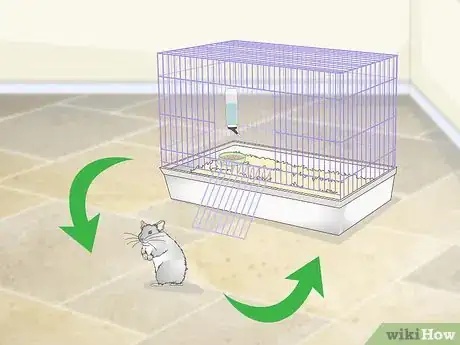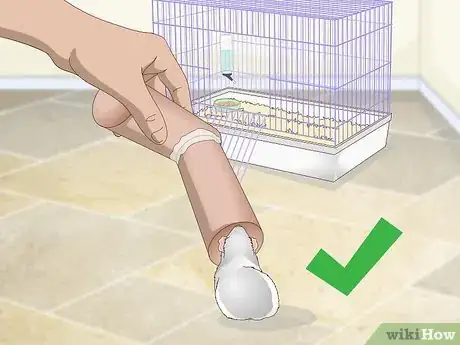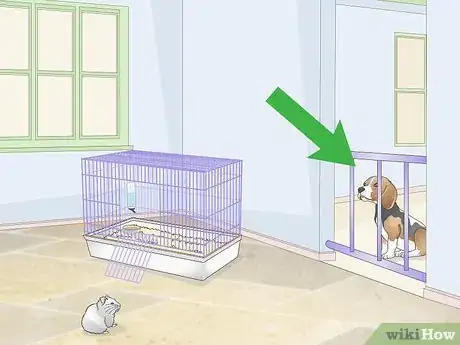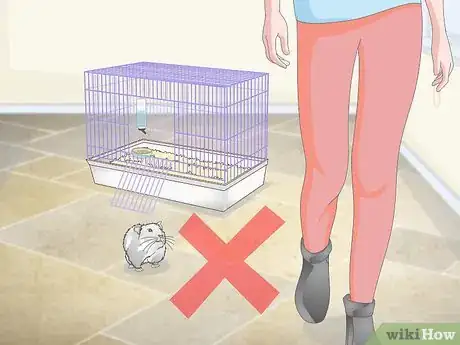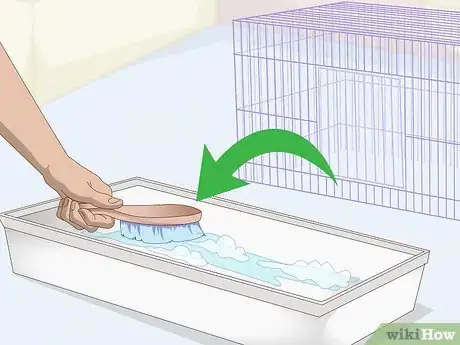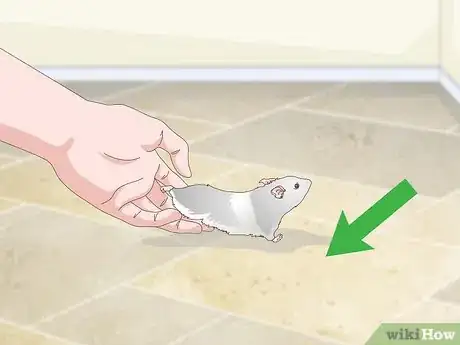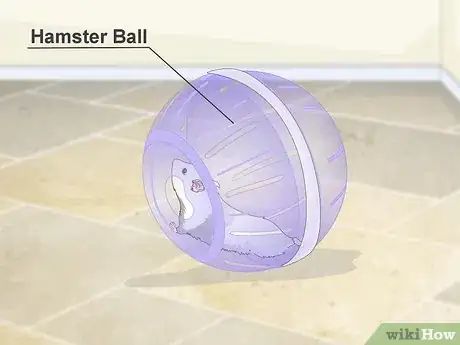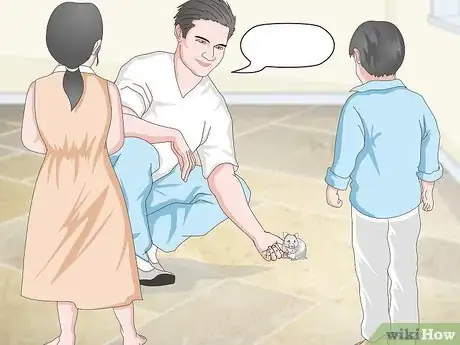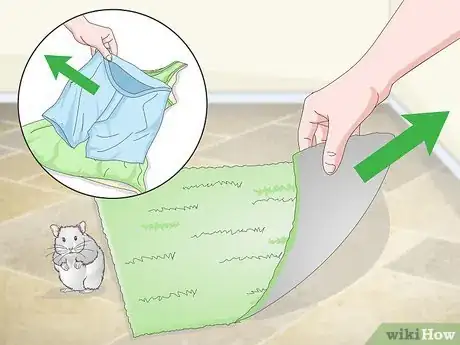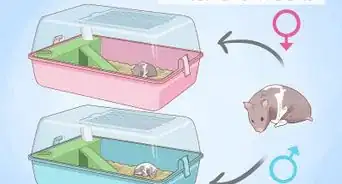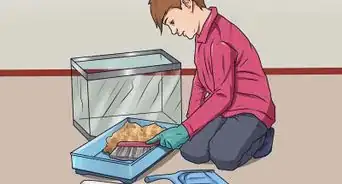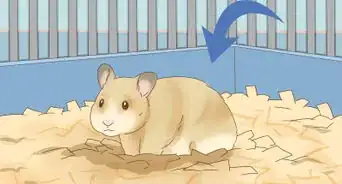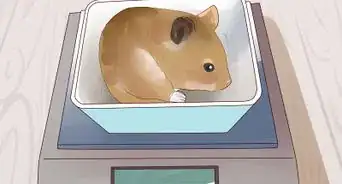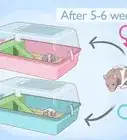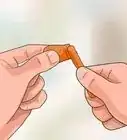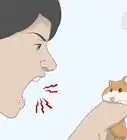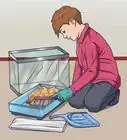This article was co-authored by Lauren Baker, DVM, PhD. Dr. Lauren Baker is a Veterinarian and Assistant Scientist at the University of Wisconsin-Madison. With over 10 years in veterinary medicine, she specializes in the concept of “one health,” which uses insights from veterinary medicine to help human medical research. She holds a Ph.D. in Comparative Biomedical Sciences, a Doctor of Veterinary Medicine, an MS in Comparative Biomedical Sciences, and a Bachelor’s degree in Psychology from the University of Wisconsin-Madison.
wikiHow marks an article as reader-approved once it receives enough positive feedback. In this case, 84% of readers who voted found the article helpful, earning it our reader-approved status.
This article has been viewed 60,905 times.
Many owners make the mistake of not properly supervising their hamsters when they let them out of their cage. The rodent may get injured or even lost if you do not supervise it properly. In order to properly supervise it while it is out of its cage, you need to provide a safe environment and keep a constant eye on the hamster. With some planning and care you can allow your hamster to have quality time outside of its cage on a regular basis, ideally daily.[1]
Steps
Watching a Hamster While It's out of Its Cage
-
1Check for escape routes and problem areas first. Before you let your hamster out, take a quick look around. Try to spot any places where your hamster might be able to hide or slip out of the room. Close any open doors and block off areas where your hamster could potentially hide, such as heating or cooling vents and spaces behind or under furniture. Also keep an eye out for potential hazards, such as hot surfaces or exposed wires.
-
2Let your hamster out of its cage carefully. Hamsters are really fast and are often hard to catch, so be sure you have a good grip on it before you lift it out of its cage. Move the hamster quickly to the area where you want it to spend time out of its cage.
- When handling hamsters, don’t be shocked (and don’t drop them) if they nibble or bite you.
Advertisement -
3Make sure that it stays nearby. While you have the hamster out of its cage, you need to make sure that the hamster does not run off. If your hamster is trying to explore areas outside of the area you have established for it, then you will need to pick it up and put it back in its pen.
- Keep the hamster out of harm's way by nudging it out of areas it shouldn't be in and directing it towards toys or snacks that you have supplied.
-
4Play with the hamster. Place some toys and treats around the area for the hamster to play with. This will make the time more exciting for the hamster, and it will give it more exercise.
- You can place a variety of items in the hamster's area. In addition to giving it store bought toys, you can try giving it paper tubes to tunnel through.
-
5Keep all other pets away. Many dogs or cats would love to get a hamster as a small treat. With this in mind, keep all pets out of the room when you take your hamster out of its cage.[2]
- Even if your other pet doesn't want to eat your hamster, its presence can scare the hamster. This in turn can cause the hamster to run away, bite you out of fear, or go into shock.
-
6Never leave the hamster unsupervised. While you have your pet out of its cage, you should never leave it alone. Keep an eye on it constantly, as a hamster can run away and hide very, very quickly.
- Even if your hamster is in a ball, you should keep an eye on it. A hamster in a ball can get into areas it shouldn't and can get injured if it accidentally rolls down an incline or down stairs. It is also still vulnerable to attack by dogs or cats.
-
7Take this opportunity to clean the cage. While your hamster is out of its cage, take the time to clean its cage thoroughly. Throw all the soiled bedding away, clean all surfaces, and then replace the bedding.[3]
- You will need another person to supervise the hamster while you do this task.
Picking an Area for the Hamster
-
1Pick a spot on the ground. Don't place your hamster on a high surface when you are letting it out of its cage. Often the hamster will be scared when you take it out of its cage, and its first instinct may be to run away. If your hamster gets free from you, it could run and fall off a high surface, injuring or even killing it.[4]
- When you have a hamster on the ground, it may still try to run away but it will not injure itself when it does.
-
2Do not use a hamster ball. Although they are convenient for you, they are dangerous for hamsters. They limit your hamster's senses so it is very difficult for them to navigate. Hamster balls don't have enough ventilation which can cause overheating and suffocation. The holes they do have for ventilation are big enough for your hamster's feet to get caught in. Just because they are sold in pet stores and online does not mean that they are safe. <ref> https://m.youtube.com/watch?v=1o1viH33O9c<ref>
- Hamster balls are not only dangerous٫ but they also provide no benefit for your hamster.
-
3Pen off an area. In order to have your hamster out of its cage safely, you should pen off an area for it to be in. Define the area by putting up barriers that the hamster cannot easily cross, such as stacks of books, boxes, or other solid barriers.
- You can use a box as a play pen if you like. A large box will give the hamster room to run around in and explore, but it will keep the animal contained.
Preparing to Let a Hamster Out of Its Cage
-
1Make sure any exposed outlets are covered up and cords are removed. Hamsters have a tendency to chew on almost everything around them. If the holes are exposed or a wire is hanging out, your hamster may chew on it and get electrocuted.
- In order to protect your hamster from the dangers of electrical outlets, put child-proofing covers on outlets that are in the area you are keeping your hamster in.
-
2Tell everyone in your home that the hamster is out. A common mistake owners can make is to forget to notify others that the rodent is out of its cage. This means that someone may open a door and allow the hamster to run away accidentally. They may even open the door and accidentally step on it. Put a sign up outside the closed door to let others know that the hamster is loose.
-
3Be cautious about any gaps in the walls or doors. Closed doors don't always keep hamsters inside. Be sure to keep a blanket stuffed under any tight spaces, since hamsters have a tendency to try to escape.
- Never give your hamster access to cracks or holes. Since they love to escape and explore, they will run towards these places. If they get into tight spaces they are likely to get trapped, injured, or lost.
-
4Be sure to remove items from reach. Hamsters will go to the bathroom and chew on anything they come into contact with. If you are letting your hamster out of its cage, it is safer to keep it away from things, such as sofas or rugs, that you wouldn't want to get ruined. Pick up all clothing and other items that might be spoiled as well.
- Hamsters love chewing on wooden items, so it is best to remove any you may have lying around.

